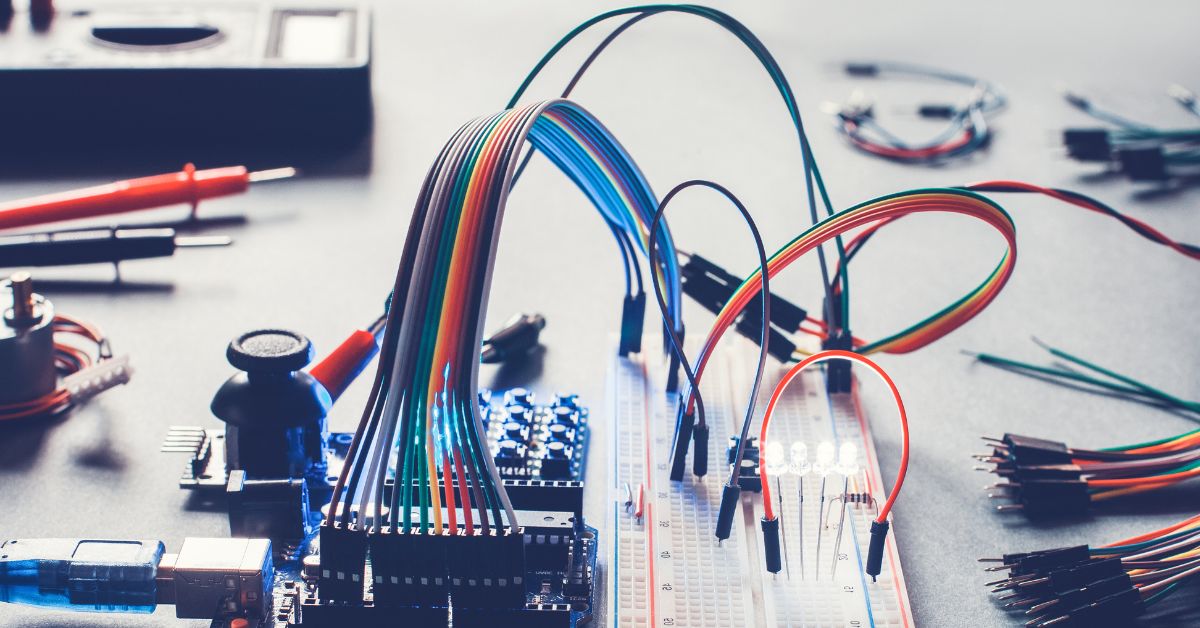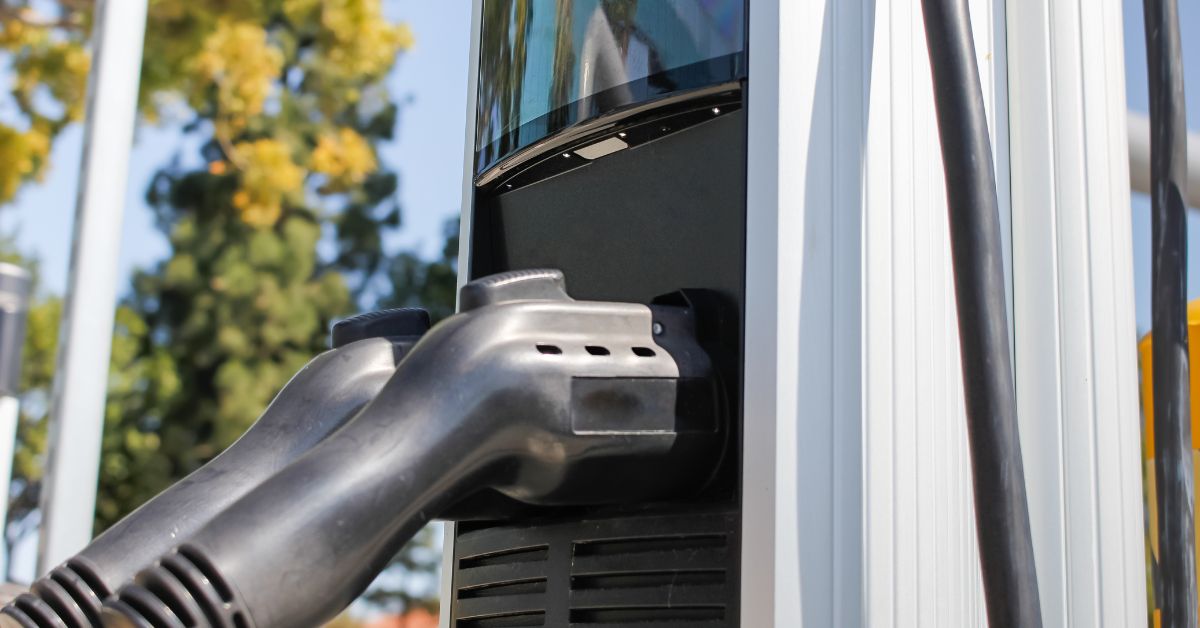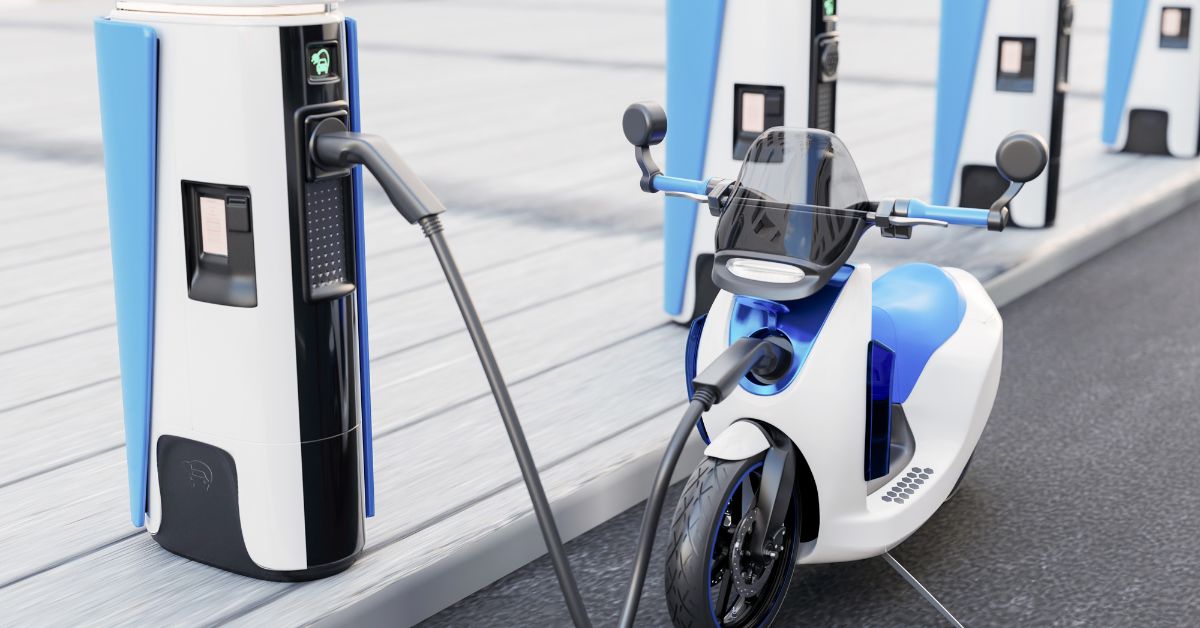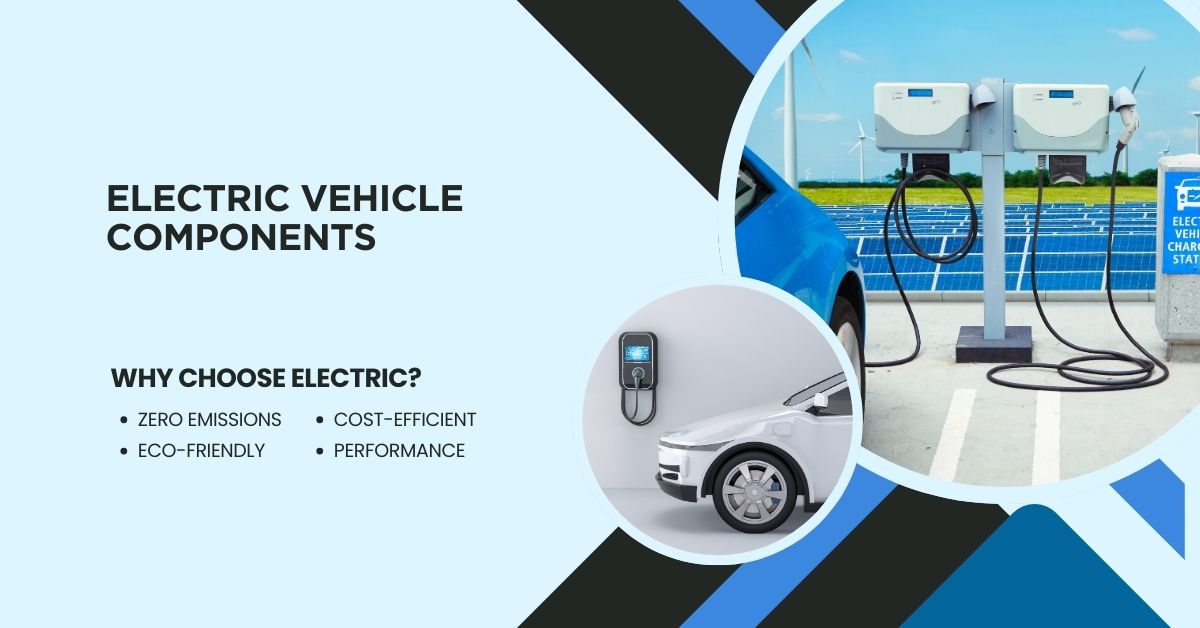Electric Vehicle Components
Electric vehicle components are designed to optimize efficiency, performance, and sustainability. Key elements include the battery, which stores and supplies energy, and the electric motor, responsible for converting this energy into motion.
The power control unit regulates the flow of electricity between the battery and the motor. Additionally, the onboard charger converts AC power from charging stations into DC for battery storage. The battery management system monitors and ensures the health of the battery cells. Other essential components include regenerative braking systems that recapture energy, thermal management systems to maintain optimal temperatures, and lightweight chassis materials to enhance overall performance.
Table of Contents
Electric Vehicle Components A Comprehensive Guide
The electric vehicle (EV) market is rapidly expanding as the world transitions from traditional internal combustion engine (ICE) vehicles to more sustainable forms of transportation. EVs, which operate using electric power, are seen as one of the most promising solutions to the global challenge of reducing carbon emissions. As the technology continues to evolve, understanding the various components that make up an electric vehicle is crucial for both consumers and automotive enthusiasts. This article will explore the key components that drive electric vehicles, their functions, and the future potential of EV technologies.
Introduction to Electric Vehicles (EVs)
Electric vehicles (EVs) represent a significant shift in the automotive technology. Unlike traditional vehicles that rely on fossil fuels, EVs are powered by electricity stored in batteries. With advancements in battery technology, the range, efficiency, and affordability of electric vehicles have improved dramatically in recent years. These vehicles offer numerous environmental benefits, including zero emissions during operation, reduced noise pollution, and the potential for sustainable energy sourcing.
However, EVs are more than just battery-powered cars. They are complex machines that rely on various sophisticated components to function smoothly. These components are designed to provide high levels of efficiency and to convert electrical energy into mechanical energy with minimal losses.
Key Components of Electric Vehicles
a) Electric Motor
At the heart of every electric vehicle is the electric motor, which is responsible for converting electrical energy from the battery into mechanical energy, which in turn propels the vehicle. Electric motors are much simpler than internal combustion engines (ICEs) and have far fewer moving parts, leading to less wear and tear, lower maintenance costs, and higher reliability.

There are several types of electric motors used in EVs, with the most of common being:
- Induction Motors: These are AC motors that use electromagnetic induction to generate power. Tesla’s vehicles, for example, predominantly use induction motors.
- Permanent Magnet Synchronous Motors (PMSM): These motors utilize magnets to create a magnetic field, resulting in more efficient operation, particularly at lower speeds. Many automakers, including Nissan and BMW, use PMSMs in their EVs.
- Brushless DC Motors (BLDC): These motors are widely used in small and medium electric vehicles due to their efficiency and reliability.
The choice of motor depends on the specific requirements of the vehicle, such as power output, efficiency, and cost.
b) Battery Pack
The battery pack is arguably the most crucial component of an EV, as it stores the electrical energy that powers the vehicle. Most electric vehicles today use lithium-ion batteries due to their high energy density, longevity, and ability to be recharged repeatedly.
Battery packs are made up of several battery cells arranged in modules. The capacity of a battery pack is measured in kilowatt-hours (kWh), and this determines how far the vehicle can travel on a single charge. For example, the Tesla Model S offers battery options ranging from 75 kWh to 100 kWh, with corresponding ranges from 300 to over 400 miles per charge.
Battery technology is constantly evolving, and researchers are exploring alternatives to lithium-ion, such as solid-state batteries and lithium-sulfur batteries, which promise higher energy densities, faster charging times, and increased safety.
c) Power Electronics Controller
The power electronics controller (or inverter) is the brain of the EV’s propulsion system. It regulates the flow of electricity between the battery and the electric motor, controlling the vehicle’s speed, torque, and overall performance. The power electronics controller converts direct current (DC) from the battery into alternating current (AC) required by most electric motors.
Additionally, this component manages regenerative braking, which converts the vehicle’s kinetic energy back into electrical energy during braking, replenishing the battery and improving overall efficiency.
d) Onboard Charger
The onboard charger is responsible for converting the alternating current (AC) from an external charging station into the direct current (DC) required to charge the EV’s battery. Most home charging systems supply AC power, which is why this conversion process is necessary.
Onboard chargers vary in terms of power rating, typically ranging from 3.3 kW to 22 kW, depending on the EV model and charging infrastructure. Higher power chargers can significantly reduce charging time, although they are more expensive to manufacture.
e) Regenerative Braking System
One of the key features that differentiate electric vehicles from conventional ICE vehicles is the regenerative braking system. In a traditional car, braking generates heat that is lost to the environment. In an EV, regenerative braking captures this energy and sends it back to the battery.
When the driver presses the brake pedal, the electric motor switches to generator mode, converting the vehicle’s kinetic energy into electricity. This not only extends the range of the vehicle but also reduces wear on the mechanical brake system.
f) Thermal Management System
The thermal management system plays a crucial role in maintaining the optimal operating temperature of the EV’s components, particularly the battery pack and electric motor. Extreme temperatures, whether hot or cold, can negatively affect the performance and longevity of these components.
EVs use a combination of liquid cooling, air cooling, and heat pumps to manage temperatures. Liquid cooling is commonly used in high-performance EVs to regulate the temperature of the battery and motor, while air cooling is used in smaller or less expensive vehicles.
A well-designed thermal management system ensures that the vehicle operates efficiently, even in extreme climates, and helps prevent overheating, which could damage the battery or motor.
g) DC-DC Converter
Electric vehicles typically operate on a high-voltage system, with voltages ranging from 300 to 400 volts, and in some cases, even higher. However, certain auxiliary components, such as the lighting, infotainment system, and climate control, require a lower voltage (usually 12 volts). This is where the DC-DC converter comes in.
The DC-DC converter steps down the high-voltage power from the main battery to the low voltage required by auxiliary systems. It ensures that these systems can operate without drawing power directly from the high-voltage battery, thereby preserving energy for propulsion.
h) Electric Powertrain
The electric powertrain is the system that transmits power from the electric motor to the wheels of the vehicle. In many EVs, the powertrain is simpler than in ICE vehicles, as it does not require complex gearboxes or transmissions.
There are two main types of electric drivetrains:
- Single-speed transmission: Most EVs use a single-speed gearbox because electric motors provide a wide range of power and torque at varying speeds, eliminating the need for multiple gears.
- Dual-motor setup: Some EVs, particularly performance models, have dual motors—one for the front wheels and one for the rear wheels. This not only improves performance but also enhances traction and handling.
i) Charging Port
The charging port is the interface between the EV and the charging infrastructure. There are several types of charging ports, depending on the charging standard adopted by the automaker:

- Type 1 (SAE J1772): Used mainly in North America, this port supports both AC Level 1 (120V) and AC Level 2 (240V) charging.
- Type 2 (Mennekes): Common in Europe, this port supports AC charging and is compatible with both home and public charging stations.
- CHAdeMO: A DC fast-charging standard commonly used in Japan.
- CCS (Combined Charging System): A fast-charging standard that combines AC and DC charging capabilities, widely used in Europe and North America.
- Tesla Connector: Tesla vehicles have their proprietary connector, although adapters are available for compatibility with other charging standards.
j) Auxiliary Battery
In addition to the main high-voltage battery, most EVs have a 12-volt auxiliary battery similar to those found in conventional vehicles. This battery powers auxiliary systems such as the infotainment system, lights, and power windows.
The auxiliary battery is charged by the DC-DC converter and provides a backup source of power in case the main battery is depleted. It also ensures that the vehicle’s critical systems can continue operating even if the main battery is disconnected or turned off.
How These Components Work Together
Each of the components mentioned above plays a vital role in the overall functioning of an electric vehicle. Together, they create a seamless system that transforms stored electrical energy into mechanical motion while ensuring efficiency, safety, and comfort.
For instance, when you accelerate in an EV, the power electronics controller regulates the flow of electricity from the battery pack to the motor. The motor then converts that electrical energy into mechanical energy, propelling the vehicle forward. At the same time, the thermal management system ensures that both the battery and motor remain within their optimal operating temperature ranges.
When the vehicle decelerates, regenerative braking captures energy that would otherwise be lost and feeds it back into the battery, extending the driving range. Meanwhile, the DC-DC converter steps down the high-voltage battery’s output to provide power to auxiliary systems like the headlights, radio, and air conditioning.
The Future of EV Components
As electric vehicle technology continues to evolve, several exciting advancements are on the horizon.

- Solid-State Batteries: One of the most anticipated breakthroughs is the development of solid-state batteries. These batteries use a solid electrolyte instead of the liquid electrolyte found in conventional lithium-ion batteries. They promise to offer higher energy density, faster charging times, and improved safety. Automakers like Toyota and BMW are heavily investing in this technology, and we may see solid-state batteries in EVs within the next few years.
- Faster Charging Systems: The development of ultra-fast charging systems could reduce charging times from hours to just minutes. Companies are working on improving both the charging infrastructure and battery chemistry to make this a reality.
- Lightweight Materials: As automakers look to improve the efficiency of their vehicles, they are increasingly turning to lightweight materials like carbon fiber and advanced aluminum alloys. These materials reduce the overall weight of the vehicle, which in turn improves range and performance.
- Vehicle-to-Grid (V2G) Technology: Another emerging trend is vehicle-to-grid (V2G) technology, which allows EVs to draw power from the grid and feed it back into it. This could help stabilize the grid during peak demand periods and provide EV owners with an additional revenue stream.
- Autonomous EVs: With the rise of autonomous driving technology, the components of EVs will need to integrate more sensors, processors, and advanced software systems. This will require greater energy efficiency to ensure that both autonomous systems and propulsion systems can function simultaneously without drastically reducing the vehicle’s range.
FAQs About Electric Vehicle Components
Q1. What are the key components of an electric vehicle (EV)?
The main components of an electric vehicle include the electric motor, battery pack, power electronics controller, onboard charger, thermal management system, transmission, and regenerative braking system.
Q2. How does the electric motor in an EV differ from a traditional combustion engine?
Unlike combustion engines, which burn fuel to create energy, electric motors use electricity from the battery to generate mechanical power directly, resulting in smoother and more efficient performance.
Q3. What types of electric motors are used in EVs?
Common types of electric motors used in EVs are DC brushed, DC brushless, permanent magnet synchronous motors (PMSM), and induction motors. Each offers different efficiencies and power outputs.
Q4. How do EV batteries work, and what types are commonly used?
EV batteries store electrical energy and supply it to the motor. Lithium-ion batteries are the most common due to their high energy density, but other types like solid-state batteries are being developed.
Q5. What is a Battery Management System (BMS) and why is it important?
The BMS monitors and manages the battery pack’s state of charge, temperature, and health. It ensures the battery operates within safe limits and optimizes performance and longevity.
Q6. How does regenerative braking work in electric vehicles?
Regenerative braking recovers kinetic energy during deceleration and converts it back into electrical energy, which is stored in the battery. This process helps extend the driving range.
Q7. What role does the inverter play in an electric vehicle?
The inverter converts the DC power from the battery into AC power to run the electric motor. It also works in reverse during regenerative braking to convert AC power back to DC for battery charging.
Q8. How does the thermal management system affect EV performance?
The thermal management system regulates the temperature of the battery, motor, and other components. Effective temperature control prevents overheating, improving performance and extending component life.
Q9. What is an EV’s power electronics controller, and what does it do?
The power electronics controller manages the flow of electrical energy from the battery to the motor. It regulates the speed and torque of the motor, ensuring efficient driving performance.
Q10. How does the charging system in an EV function?
The charging system includes the onboard charger and charging port. It converts the incoming AC power from the grid into DC power to charge the battery and manages the charging rate to prevent overcharging.
Electric vehicles are revolutionizing the automotive industry, offering a cleaner and more sustainable alternative to traditional gasoline-powered cars. Understanding the components that make up an EV—from the electric motor to the battery pack, power electronics, and regenerative braking systems—helps to appreciate the complexity and innovation behind these machines.
As battery technology improves, charging infrastructure expands, and EV components become more efficient, electric vehicles’ future looks promising. Whether you’re a car enthusiast, a potential buyer, or simply curious about the future of transportation, electric vehicles and their components are shaping the road ahead.
With advancements on the horizon, such as solid-state batteries and vehicle-to-grid technology, the next decade will likely bring even more innovation, making electric vehicles not only more accessible but also a key part of our transition to a more sustainable world.
Electric vehicle components are pivotal in shaping the future of sustainable transportation. Each part, from the battery and motor to the charging system and software, plays a critical role in enhancing vehicle performance, efficiency, and environmental impact. As technology advances, these components are becoming more refined, leading to longer driving ranges, faster charging times, and reduced costs.
The integration of advanced battery technologies, such as solid-state batteries, and innovations in electric motors will continue to improve vehicle efficiency and sustainability. Moreover, the role of the battery management system (BMS) ensures optimal performance and safety, while the regenerative braking system contributes to energy conservation. The synergy between these components is what drives the success of electric vehicles, making them a viable alternative to internal combustion engine cars.
As the industry grows, manufacturers will focus on enhancing the reliability, affordability, and availability of EV components to meet the increasing global demand. Ultimately, understanding these key components helps consumers and industry professionals alike appreciate the complexity behind electric vehicles and their potential to revolutionize transportation. The continuous evolution of these systems promises a cleaner, more efficient future for mobility.
Click here to learn more about Electric Vehicle Components
Click here to learn more about Electric Vehicle Car Advantages and Disadvantages
